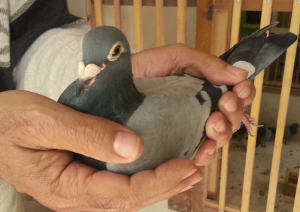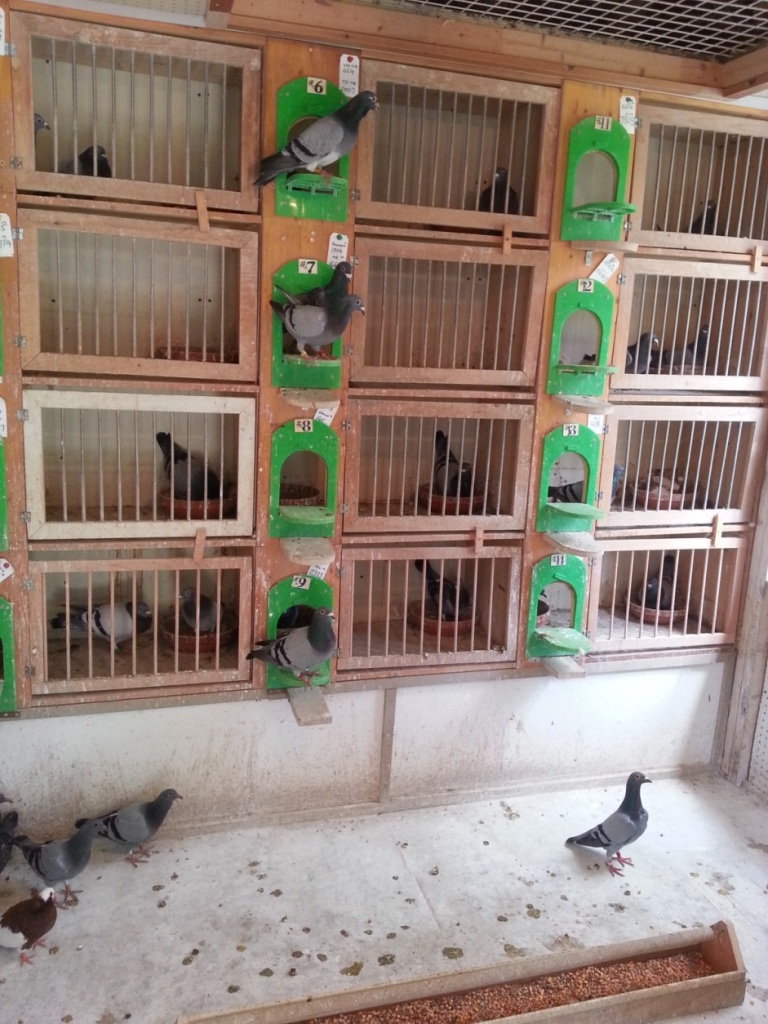The Loft Report: Guido Madrusan Pigeon Empire

The Loft Report
Guido Madrusan Pigeon Empire
©Silvio Mattacchione BA MA
 I have not taken the time to write about any fanciers since preparing my very detailed article on David Clausing whom I consider the originator of the finest and most successful “one Loft racing” family in the world today. My extensive Clausing article came about as the result of an important article I wrote on Manuel Rodriguez/Gallo Lofts and the one loft race results at the Canadian International .Interestingly enough the genetics of these two Floridians has had a very far reach. In the Clausing case the affect, without question has been Global and in the Gallo case it is becoming significant in the USA and Canada.
I have not taken the time to write about any fanciers since preparing my very detailed article on David Clausing whom I consider the originator of the finest and most successful “one Loft racing” family in the world today. My extensive Clausing article came about as the result of an important article I wrote on Manuel Rodriguez/Gallo Lofts and the one loft race results at the Canadian International .Interestingly enough the genetics of these two Floridians has had a very far reach. In the Clausing case the affect, without question has been Global and in the Gallo case it is becoming significant in the USA and Canada.
June 9th 2014 was one of those days that I will remember for a very long time .Why? Well apart from it being a truly wonderful early summer day, not to hot, really fresh, predominantly blue sky my friend Martin Hechanova and I were on a mission. We were driving to the “Empire” to the “Pigeon Empire” to be precise, the lofts owned by NPA Master Breeder and NPA Show Judge Guido Madrusan. Guido is located in Simcoe, Ontario and his property (which he had purchased at 24 years of age) is nestled in truly wonderful farm country, with open, expertly maintained farm fields that grown everything from luscious fruits, to ginseng, tomatoes and yes even tobacco. Sandy soils, productive, ideally located and did I mention that all this was, only a brief three hour trip south west of Port Perry Ontario. A community , that as far as I could observe, had no rush hours to speak of, no smog, no urban sprawl, no bedroom commuting .Located on just over an acre we were greeted by Guido as we arrived. He was happy that we made it, almost on time, given that our GPS was not quite as efficient as it might otherwise have been, requiring both my written notes as well as two telephone calls to Guido to complete our journey to his door.
The front of the property was well treed and one would never suspect that this property housed some truly marvelous one loft racing pigeons. Once we got to the back of Guido’s home the exceptionally well maintained lofts were to the West property line. Directly in front of us two paddocks that housed a remarkable 23 year old quarter horse that still looked in its prime, and scouring the paddock for bugs were a troop of wonderful red hens. All in all, a veritable paradise.
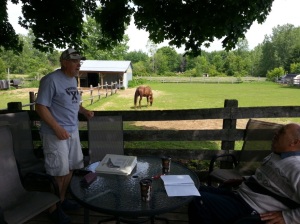 We sat under a huge Norway maple tree that formed a giant umbrella overtop of a ground level wooden deck that Guido advised was his “command post”.
We sat under a huge Norway maple tree that formed a giant umbrella overtop of a ground level wooden deck that Guido advised was his “command post”.
Shaded, bug free with a remarkable and comfortable view of the lofts and the paddocks, and most important, in close proximity to the gas barbeque. Nothing was over-looked; we sat around a glass topped patio table, on comfortable patio chairs sipping our tea as Guido began to give us a brief history of his life with both fancy and racing pigeons. We had a wonderful lunch comprised of butcher made Italian sausages, grilled to perfection, and fresh garden salad with olive oil and balsamic dressing.
Guido is a quiet man, exceedingly well spoken, observant to the nth degree, dedicated to achieving success, on his terms with everything he does. He reminded me a great deal of my close friend and champion Tippler fancier, (who recently passed away) Kemo Basic. Interestingly enough these two men, both Champions in their respective breeds were also both Croatian by birth.
Now I do not use the term Champion lightly for Guido is an NPA Master Breeder – 2000 (Guido was the first of only two Canadians to Receive this Award ) as well as an NPA Master Judge – 2001 (Guido is the only Canadian To Receive this Certificate). The NPA is a national organization founded in 1920 with national offices in California and officially sanctioned shows across the USA. Guido is a grocer by occupation and has been in this field for over 38 years having managed a store for over 27 years. Pigeons fascinated Guido from an early age and it seems that his uncle had the very same passion. As a youngster Guido sat for hours, watching a neighbors pigeons from the top of a nearby hill. That neighbor with his many breeds was probably the biggest influence of Guido’s growing fascination for these incredible birds of ours.
For nearly five decades Madrusan focused solely on show birds, specifically Komorner Tumblers. Show birds had allowed him to traverse North America as he visited and often won most major shows across the continent. The trophies and plaques from six consecutive NPA Nationals and fifteen consecutive Woodstock Specialty Shows still inhabit various corners of his home. However according to Madrusan the real reward came in the form of truly appreciating the bonds created and friendships forged. This was the true reward and the mark of a real Champion.
Madrusan has bred large numbers of Champion show pigeons that he has exported to countries around the world on a regular basis, to this, add the breeding of a champion Doberman by Tracy -Guido’s wife (and no surprise here he even knew Jim McLean my partner that judges major Doberman competitions in both Canada and the USA) and has been fortunate enough to select a few exceptional show horses.
I first came across Madrusan’ s name in 2008, when I viewed the 2008 Empire Classic equal 1st race winners in Bright , Ontario.
Guido’s 2008 Equal 1st Empire Classic winner was a Horeman down from Carl Loizzi stock, descendants I believe, of Horeman “2900”. Carl flew very successfully in the FVC Combine(Fernando Valley Combine)These Horeman dominate FVC racing and Snowbird Classic races and were original imported as eggs by Pete Lorenz in the 1970’s. They immediately decimated their competition and it didn’t take long for Pete to supply his brother Ed as well as their father Leo Lorenz. Carl got them in 1983 when he attended his first auction which just happened to be the final dispersal of the Horeman pigeons of Leo Lorenz. These Horemans are pretty much a tightly held, highly desirable, group of performance pigeons that are jealously maintained by Carl, the Lorenz brothers and a few close friends.
 As I made mental note of his continued racing activities I was fascinated by the “Madrusan” story. His achievements in one loft racing in Canada took place in a very short period of time. No doubt he was a “man on a mission”. He had a well thought out plan and he seemed to be executing it flawlessly. The majority of racing pigeon fanciers would benefit enormously by taking the approach and lifelong experience of Madrusan to heart. Imagine all of this by what most racing pigeon fanciers, in their arrogance, would refer to in a deprecating fashion as a “fancy pigeon guy”.
As I made mental note of his continued racing activities I was fascinated by the “Madrusan” story. His achievements in one loft racing in Canada took place in a very short period of time. No doubt he was a “man on a mission”. He had a well thought out plan and he seemed to be executing it flawlessly. The majority of racing pigeon fanciers would benefit enormously by taking the approach and lifelong experience of Madrusan to heart. Imagine all of this by what most racing pigeon fanciers, in their arrogance, would refer to in a deprecating fashion as a “fancy pigeon guy”.
There is an uncalled for and undeserved “superiority complex” that infects most racing pigeon fanciers. Generally speaking these fanciers delude themselves as regards the supposed inherent inabilities of “show or fancy pigeon enthusiasts.
After nearly five decades of focusing solely on show birds, specifically Komorner Tumblers, Guido made the transition to racing in 2006.Though Guido initially started with white racers, for ceremonial releases, it did not take long for the idea to percolate and brew into full out racing within less than a year. When I asked, “Who inspired this fascination?” Guido responded,
…actually, the first Fed. meeting I went to a flyer said to me verbatim “you will see how hard racing is compared to show birds” this was it, the competitive nature in me thought, oh yea, just watch me!
So it seems that the gauntlet was dropped and right after the fancier (who remains unnamed) made this remark Guido took up the challenge, with his wife and children providing moral support.
Individuals of Madrusan ability and background do indeed have an incredible advantage. Why do I say this? Because being a champion show breeder for 50 years where condition is everything and Guido was certainly very well known around the world for his conditioning skills , knowing feather structure, proper feeding at the proper time and pigeon genetics I would say he had an ace in the hole. It is hard to come to any other conclusion!
I think it safe to say that Guido Madrusan is a very competitive individual by nature, if he does something he quickly strives to be the best. Here is a direct quote, very much to the point.
I do it to win…
Our afternoon together allowed me to ask a number of questions that should be of lasting interest to novice and alleged expert alike. How does a highly experienced professional, like Madrusan, go about creating a plan that is intended to take one to the top in as short a time as possible? What I wanted to know was his overall plan, his strategy so to speak? What goals were initially important? The Optimal number to maintain? Finally how was the decision made as to which birds were to be purchased in the beginning?
How did Guido decide which birds to purchase?
…with 35 years of showing pigeons I applied the same philosophy, I wanted a few pigeons from two or three families of which some had to be birds flying our local course. I strongly believe that pigeons by selection flying the same course year after year adapt to it and therefore succeed at better then pigeons from elsewhere
Can you explain how you decided upon which birds to cultivate?
“I cultivated around the birds that raced well for me and their parents. Performance and producers of performance pigeons were the ones, names and strains never made much of an impression on me, they must fly!”
What goals were important for you to achieve initially?
“… my goal was to have birds in the top 10 % for the first year, I achieved my goal and surpassed as I topped the Combine my first year racing old birds …very pleased and proud how things turned out.”
Guido when you began how many pigeons did you decide was the optimal number of breeders and racers to keep?
I keep 16 pairs of breeders, 4 to 5 pairs of main the rest are trial pairs and Pumpers for my main breeders and my show birds , which I still keep a few…. I race Classical Widowhood, reason being it suits my timetable, fly 24 cocks
Where did these first pigeons come from?
…the first pigeons that impacted my program came from 3 sources , two cocks from Big Andy’s race team , Van Elasackers, the first one a Super breeder Mueleman/ Janssen and the second one , also a very good breeder Mueleman/Van loon , along with a Soontjen hen from Terry Humberstone and some Horemans that really did well for me that I obtained in a trade for Fancy show pigeons from Carl Loizzi from California, later some Spanjaards were added and then the Gallo birds that also did phenomenal strides forward for me.
Did you breed to a standard?
Well, I like a nice handling bird, apple body, smooth feather but performance is always priority.
Do you use line breeding or inbreeding?
I line bred with my show birds and used the same approach with the racers
Have you sought to create a line or strain or family?
Right now I am striving for performance and I am sure the Family will come together with time.”
I understand that you made use of my Spanjaards via Gardi Gamboa.
The reason I bought them was that they were excelling in one loft races… I was planning to start a one loft family of my own… I strongly believe that a successful one loft Family has to be cultivated from birds that competed and excelled in one loft racing.
Why are these Spanjaards pigeons important and do you think this mating has special significance and why?
… Because my plan for them (the Spanjaards) worked and they succeeded for me in one loft and Club racing
What role will these “Spanjaards “pigeons play in the future of your family of birds?
If they keep contributing to success they will be a big part of the future.
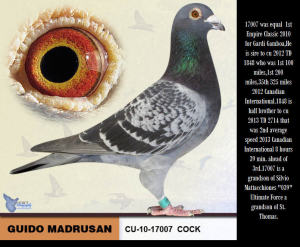 Will they be used as a cross for International one loft racing?
Will they be used as a cross for International one loft racing?
…17007 was mated to one of my Horeman hens and produced TD 1848 / 12 , he was raced at the Canadian International One loft race, placed 1st at 150 miles , he was Equal first at 200 and was 37th at 325 miles.
How are the children of 17007 doing?
… Have 1848 in the breeding loft and two other brothers on my racing team, all doing well so far, showing great promise.
It has often been said that the females are the key to the long term continued success of any line of animals?
Funny you asked that, all my life I was partial to my hens, being the show birds or racers they are the backbone of the loft, you can purchase a good cock anywhere but nobody will easily part with a good hen.
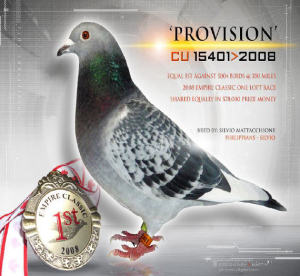 During one of our telephone conversations Guido referred to two nest mates Spanjaard hens that were bred by Gardi Gamboa and that were doing exceptionally well for him.I asked the parentage only to discover that the Dam was “15401” a hen I bred called “Provision” that was equal 1st at the 2008 Empire Classic (same year that Guido was also equal 1st) and the Sire was also bred by me, a strawberry number “12”.Both these birds were crosses onto my Spanjaards hen line.
During one of our telephone conversations Guido referred to two nest mates Spanjaard hens that were bred by Gardi Gamboa and that were doing exceptionally well for him.I asked the parentage only to discover that the Dam was “15401” a hen I bred called “Provision” that was equal 1st at the 2008 Empire Classic (same year that Guido was also equal 1st) and the Sire was also bred by me, a strawberry number “12”.Both these birds were crosses onto my Spanjaards hen line.
I asked Guido if he could provide detailed results for the breeding/racing record of these Spanjaards nest mates.
One of the two Spanjaards hens I got from Gardi, raised me two brothers, both topped the combine for me and they were 1st and 2nd one time.
Since then, all has gone well for Guido. He has topped the combine nine times, won opens, finished first in the 2008 Empire Classic and was recently awarded the club’s King Bird Flyer for the first time in 2011.
The way that I see it, a pigeon is a pigeon. If you keep it healthy, in top condition, and in the proper environment, it will do whatever you ask of it; be that confirmation and markings or finding its way home from five-hundred miles away. The key to success, regardless of arena, is looking after the birds and genuinely seeing what you are looking at. The pigeons will tell you how they feel and how they will perform for you. The ability to spot and interpret their signals absolutely separates the ordinary pigeon person from the successful one. It’s not a talent than can be taught or learned, it’s a talent accrued through time spent with the birds.
After viewing a number of excellent breeding specimens I was totally taken by an incredible eleven year old checker hen. I asked what she was and was told that she was a Horeman. Horeman? What is a Horeman? I eventually took to the internet to do some quick research. Charlie Barbiere had written an article that was quite informative .It turns out they are an old Belgian breed that have actually been extensively used in other strains very much like the Wegges were. Bill Richardson made an interesting observation that immediately resonated with me.
From the start, the Horeman were more my type of pigeon, especially since they are very much a hen based family. —Bill Richardson reference:
There are so many things that I can say about these pigeons! They are on the smaller side and they have an excellent strength to weight ratio, they have super vitality, they love to fly, and they inbreed extremely well. They have had tremendous success from 100 to 500 miles, and because they mature quickly, they do especially well at young bird distances of 300 and 400 miles as evidenced by the fact that they won the 400 Snowbird Futurity in 2000 and 2001 against some of the best pigeons this Country has to offer.”— Bill Richardson
As so often happens when I start writing an article I eventually try and contact some of the key players that are referred to. The fact that the Horemans that Guido acquired came from Carl Loizzi of California gave me the opportunity to call and then correspond by email. Carl has been enormously successful with racing pigeons. He is a gentleman, articulate, thoughtful and measured in his words unfortunately he did not have a website. Carl did take the time to provide some very interesting history that most will be unaware of.
The Horeman have brought me over 30 years of fun and success. The one piece of info that I can give you is that when Pete Lorenz unexpectedly passed away 9 years ago. Since Ed was grieving and Pete’s wife had no use for the birds. I arranged a private sale for his complete loft. The birds were split by draw between 3 local fanciers Ed and myself. I drew 2900 the most perfect racing specimen you could ever handle. You referenced him in your article. Guido’s Empire classic winner I believe is down from him. He was a cross one of the few Pete kept. He was a brick red. Bruno Lascarain was a new fancier to the area that couldn’t touch sides. He bought in and with a pair from Pete Dubbed the HIT PAIR bred the Snowbird winner for Danny Hinds the very next year. Bruno went on to challenge me in 07 for A.U Hall of fame best bird in young birds. We finished 1, 2 in the country. All Horeman. These birds cross very well. They add body, eye depth, silky feathers and the will to come home.” — Reference personal correspondence with Carl Loizzi
Most fanciers speak of goals but not often do they understand the initial importance of attainable goals. Guido most certainly did and his reply to my inquiry is of great importance.
When you decide to enter a new foray, be that racing pigeons, showing pigeons or even life, it’s important to set attainable goals that you can build upon while throttling your expectations. You probably will not win in your first year as you undertake the same learning curve that every other club member underwent. Setting small expectations, just as I did in my first year when I originally celebrated the return of all of my birds to their loft, allow you to build your confidence…. Through trial and error and almost excessive documenting, you’ll be presented with the information required to succeed. As I mentioned earlier though, making use of that information is about seeing what you are looking at. The birds are intellectually malleable little creatures, so adapt them to your management style. You are the boss, so make it as simple and convenient as possible for both you and the birds. Flying, feeding and cleaning schedules are all at your discretion to set, but the timing must be constant.
There are people in this world who are exceptional breeders of animals who know very little of science or genetics but who seem to have a sixth sense, something I call “Stock Sense”. It would seem to me that Madrusan has both the genetic knowledge as well as the science but he also has this intuitive “Stock Sense” in spades? You will be interested in Guido’s response.
I call it Pigeon talent Silvio, you either have it or you don’t, something that you can- not explain or teach, you see what you are looking at, you can see something is going to be wrong with a certain pigeon way before it happens, you can smell if something is out of the ordinary in your loft, etc. like I always say there are many hockey players but there is only one Wayne Gretzky.
I believe that Guido sees exactly what he is looking at when it comes to pigeons. He is a perfectionist and he works hard at it and clearly it works and works so very well. Guido prefers a medium sized apple bodied pigeon, with balance and silky feather. He has certainly shown that hard work, keen observation, intuitive stock ability trumps any supposed advantages that wealth might give a fancier. Buying expensive pedigree stock almost never equates to success. He further believes that accurate pedigrees are great tools but are not crucial until and unless performance has been well established. Always measure your success according to the performance results attained and allow your winners to set your breeding direction. Try to keep it simple, good feed, a clean, healthy, well ventilated loft, no secrets or potions just a great deal of hard work.
The pigeons that win races for me are my flyers and their parents are my breeders and they are the most important pigeons in my loft …always seeking knowledge, always planning the next move forward, never stand still,…But the most important , never satisfied with your results , always striving for improvement.
The way that I see it, a pigeon is a pigeon. If you keep it healthy, in top condition, and in the proper environment, it will do whatever you ask of it; be that confirmation and markings or finding its way home from five-hundred miles away. The key to success, regardless of arena, is looking after the birds and genuinely seeing what you are looking at. The pigeons will tell you how they feel and how they will perform for you. The ability to spot and interpret their signals absolutely separates the ordinary pigeon person from the successful one. It’s not a talent than can be taught or learned, it’s a talent accrued through time spent with the birds. Almost through osmosis, you begin to absorb the requisite knowledge that allows you to recognize the patterns associated with winning birds and to sift through the minutia connected to them. After the little things are looked after, the larger goals like winning races or shows often fall into place without a concerted effort. Like I mentioned earlier, condition and health, along with the dedication required to maintain them, are the main contributors to success: proper perches, a variable feeding schedule depending on time of the year, appropriate ventilation and a clean loft are of the utmost importance.
If you decide to try racing and are ready to acquire stock, forget the big names and expensive birds. My best birds are the ones that were gifted to me or were purchased at minimal cost from local flyers. It’s impossible to quantify, but the exquisite genetics that accompany expensive birds still only account for fifty percent of your possible success. You, and the conditions that provide for the birds, account for the remaining fifty percent. It’s imperative to remember that a top bird in poor condition will get beat by mediocre birds in top form every week of the year. In other words, the difference between average and greatness lies not in the pedigree but literally in your hands as the breeder and loft manager.
This entry was posted on Monday, September 15th, 2014 at 6:33 pm
You can follow any responses to this entry through the RSS 2.0 feed.
Tags: Article, Guido, Pigeon Empire, Silvio Mattacchione, The Loft Report
Posted in: Article



